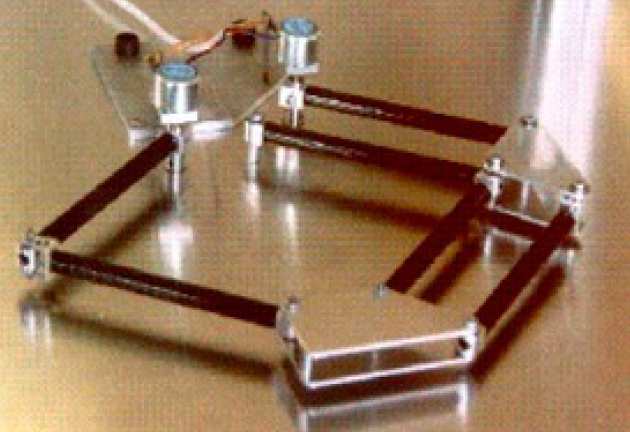Dynamics and control of 2, 3 and 6 DOF parallel manipulators
 This project is done in collaboration with Alain Codourey and Marcel Honegger, from ETH-Zuerich and Laurent Rey from EPF-Lausanne, in Switzerland. Our aim is to develop methods for the control of fully parallel manipulators and test them experimentally.
This project is done in collaboration with Alain Codourey and Marcel Honegger, from ETH-Zuerich and Laurent Rey from EPF-Lausanne, in Switzerland. Our aim is to develop methods for the control of fully parallel manipulators and test them experimentally.
The advantages of fully parallel manipulators over serial ones are well known: the parallel mechanical structure is more rigid than a serial one, and the motors can be placed at the basis of the arms. Very light limbs can be used and high velocity and acceleration can be attained. This high dynamics and the large dynamic coupling between the axis however make a nonlinear control necessary. Our work aims to design and implement nonlinear control strategies for parallel manipulators. These strategies must be realizable using standard hardware and fulfill the typical industrial requirements of simplicity and efficiency.
Using Kane's algorithm, a method was developed for finding the dynamic equation of any system of rigid bodies and bringing it in a compact linear form. In this form, the equation is ready for the identification of its parameters and can be computed in real-time with current hardware. For parallel manipulators, this methods presents two critical advantages: (1) The closed mechanical chain must not be cut in order to work on the resulting tree structure, and (2) Simplifying hypotheses can be introduced at the very beginning of the derivation. Using this method, the dynamic equations of several 2 dof, 3 dof and 6 dof parallel manipulators have been derived.
Methods for learning and compensating the (nonlinear) dynamics were designed and tested on 2 DOF and 3 DOF parallel manipulators. A simple adaptive controller, realizing the steepest descent of the tracking error function, was selected as the best algorithm for learning and compensating the dynamics in arbitrary trajectories. It was shown that this controller is stable and robust to noise, enables identification of the friction and results in better control performance than when the parameters of the dynamic equation are measured. An adaptive look-up-table method was also designed for learning an arbitrary dynamics when the task consists only of repeating a single trajectory. This controller requires almost no computation, is trivial to implement, and results in even better control performance (for this restricted task).
These nonlinear adaptive controllers have been implemented on a 6 DOF parallel manipulator used as a milling machine. This manipulator is not equipped with velocity sensors, and a linear observer is used to estimate the velocity from the position signal. The experimental results have shown i) the necessity of using nonlinear control for such high-speed manipulators, ii) that our simple nonlinear adaptive controller can be implemented on a 6 DOF parallel manipulator and that it performs well with these very demanding dynamics (in contrast to several provably stable controllers), and that this divides the tracking error by a factor 10 or more relatively to linear control.
This results have led to collaboration with robotic industries like Panasonic.
Related publications
- A. Codourey and E. Burdet (1997) A Body-oriented Method for Finding a Linear Form of the Dynamic Equation of Fully Parallel Robots, IEEE International Conference on Robotics and Automation, Albuquerque, USA
- M. Honegger, A. Codourey and E. Burdet (1997) Adaptive Control of the Hexaglide, a 6 dof Parallel Manipulator, IEEE International Conference on Robotics and Automation, Albuquerque, USA
- A. Codourey, E. Burdet and M. Honegger (1997) Body-oriented Dynamic Modeling and Control of Parallel Robots, submitted to IEEE Transactions on Robotics and Automation
- E. Burdet and A. Codourey (1998) Evaluation of Parametric and Nonparametric Nonlinear Adaptive Controllers, Robotica 16:59-73
- E. Burdet, A. Codourey and L. Rey (1998) Experimental Evaluation of Nonlinear Adaptive Controllers, IEEE Control Systems Magazine, April: 39-47


